Home | Category: Early Mesopotamia, the Fertile Crescent and Archaeology
MESOPOTAMIA
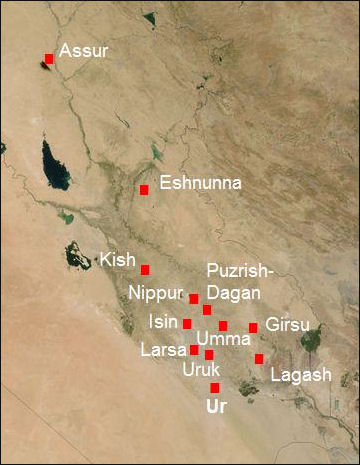
Sumerian period
Mesopotamia is Greek for “land between two rivers.” Located in southwest Asia (the Near East of Middle East), it refers to the geographic region which lies near the Tigris and Euphrates Rivers. It doesn't really refer to particular civilization. Over the course of several millennia, many civilizations developed, collapsed, and were replaced in this fertile region.
Nancy Demand of Indiana University wrote: The land of Mesopotamia is made fertile by the irregular and often violent flooding of the Tigris and Euphrates Rivers. While these floods aided agricultural endeavors by adding rich silt to the soil every year, it took a tremendous amount of human labor to successfully irrigate the land and to protect the young plants from the surging flood waters. Given the combination of fertile soil and the need for organized human labor, perhaps it is not surprising that the first civilization developed in Mesopotamia.” [Source: The Asclepion, Prof. Nancy Demand, Indiana University - Bloomington]
Mesopotamia roughly corresponds to modern Iraq. Iraq is also home to some of the most important landmarks of the Judeo-Christian tradition, including the reputed Garden of Eden and Ur, the birthplace of the patriarch Abraham. The area had a rebirth of sorts in the Middle Ages, when Baghdad became a capital of the Islamic world and culture and art thrived there and mosques sprang up throughout the region. When war occurred in Iraq in the 1980s, 90s and 2000s, many in the art and historical fields worried about what might be damaged or destroyed. [Source: Deborah Solomon, New York Times, January 5, 2003]
Large cities in the Near East in the third millennium B.C. had only around 20,000 or 30,000 people. Still, one of the most astonishing revelations of the tablets recovered from Ebla was how densely populated Mesopotamia, Syria and the Middle east were. More than 5,000 geographical names are mentioned, including names mentioned in the bible. Italian archaeologist Giovanni Pettinato told National Geographic, “We encounter a swarm of small states even in the immediate vicinity of Ebla...The enormous number of cities and villages presents an entirely new picture of the urbanization of Syria and Palestine in the third millennium B.C.
GEOGRAPHY AND CLIMATE OF MESOPOTAMIA AND LINKS TO PEOPLE THERE NOW See Separate Article africame.factsanddetails.com
Websites on Mesopotamia: Internet Ancient History Sourcebook: Mesopotamia sourcebooks.fordham.edu ; Institute for the Study of Ancient Cultures, University of Chicago isac.uchicago.edu ; University of Chicago Near Eastern Languages and Civilizations nelc.uchicago.edu ; University of Pennsylvania Near Eastern Languages & Civilizations (NELC) nelc.sas.upenn.edu; Penn Museum Near East Section penn.museum; Ancient History Encyclopedia ancient.eu.com/Mesopotamia ; British Museum britishmuseum.org ; Louvre louvre.fr/en/explore ; Metropolitan Museum of Art metmuseum.org/toah ; Ancient Near Eastern Art Metropolitan Museum of Art metmuseum.org; Iraq Museum theiraqmuseum ABZU etana.org/abzubib; Archaeology Websites Archaeology News Report archaeologynewsreport.blogspot.com ; Anthropology.net anthropology.net : archaeologica.org archaeologica.org ; Archaeology in Europe archeurope.com ; Archaeology magazine archaeology.org ; HeritageDaily heritagedaily.com; Live Science livescience.com/
RECOMMENDED BOOKS:
“Ancient Mesopotamia: an Enthralling Overview of Mesopotamian History (2022) Amazon.com;
“Mesopotamia: a Captivating Guide (2019) Amazon.com;
“Babylon: Mesopotamia and the Birth of Civilization” by Paul Kriwaczek (2010) Amazon.com;
“Mesopotamia:Civilization Begins” by Ariane Thomas and Timothy Potts (2020) Amazon.com;
“Mesopotamia: The Invention of the City“ by Gwendolyn Leick (2001) Amazon.com;
“The Legacy of Mesopotamia” by Stephanie Dalley, A. T. Reyes, et al. (2006) Amazon.com;
“Civilizations of Ancient Iraq” by Benjamin R. Foster and Karen Polinger Foster ((2009) Amazon.com;
“Ancient Iraq” by Georges Roux (1964) Amazon.com;
“Ancient Mesopotamia” by Don Nardo (2004) Amazon.com;
“DK Eyewitness Books: Mesopotamia: Discover the Cradle of Civilization—the Birthplace of Writing, Religion, and the” by John Farndon and Philip Steele (2007) Amazon.com;
“Between Two Rivers: Ancient Mesopotamia and the Birth of History” by Moudhy Al-Rashid (2025) Amazon.com;
“The Ancient Near East” Volume One by James B. Pritchard (1965) Amazon.com;
“A History of the Ancient Near East” by Marc Van De Mieroop (2003) Amazon.com;
“Dawn of Empire” a Novel by Sam Barone (2006) Amazon.com;
“Weavers, Scribes, and Kings: A New History of the Ancient Near East” by Amanda H Podany (2022) Amazon.com;
“Ancient Mesopotamia: Portrait of a Dead Civilization” by Adolf Leo Oppenheim (1964) Amazon.com
Fertile Crescent, the Cradle of Civilization and the Levant
The Fertile Crescent is region of fertile irrigated land that stretched across Mesopotamia and reached down the Mediterranean coast and included present-day Iran, Syria, southeastern Turkey, Lebanon and Israel. The Fertile Crescent gave birth to the Judaism and Christianity and shaped Muslims-Arab culture. The Levant is the “land flowing with milk and honey.” It usually referred to an area occupied by Israel, Lebanon, Jordan, western Syria and northern Arabia.
The fertile land around the Tigris and the Euphrates was the product of alluvial material and silt deposited by the rivers when they flooded in the spring. So fertile was the land it gave birth to story of the Garden of Eden. The fertile land was greatly coveted by the nomadic tribes that lived around it in Arabia, Turkey and Iran. Periodically they sweep down out of their homelands and try to claim parts it.
Mesopotamia is also referred to as the Cradle of Civilization. Most of the early Sumerian city-states in were near the mouth of the Euphrates in the southeastern Iraq and spread northward. The Babylonians were based near where the Tigris and Euphrates approach and diverge in central Iraq. The Assyrians were based around the Tigris in northern Iraq.
Mesopotamian Civilizations
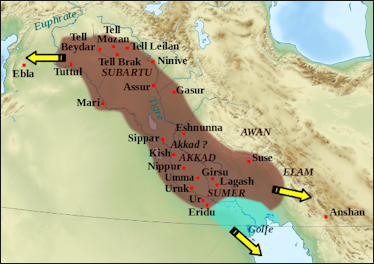
Akkadian Period The ancient Mesopotamia civilizations thrived from roughly 3500 B.C. to 600 B.C. Embracing a large region centered between the Tigris and Euphrates Rivers in modern-day Iraq, it supplied the foundation for customs and legal traditions that would later have a profound influence on European culture. Though many different societies emerged and organized cities, states, and empires in Mesopotamia, historians study these cultures together because they lived near each other and had many similarities. [Source: Encyclopedia.com =]
The great cultures of Mesopotamia consisted of the Sumerians (3500 to 2300 B.C.), the developers of writing; the Babylonians (1792-1595 B.C.), led by Hammurapi, who developed the eye-for-an-eye legal code; and the Assyrians (883-612 B.C.), the masters of warfare and the first people to effectively use chariots. The culture of Mesopotamia spread to Palestine, Greece and Rome. The Akkadians (2350–2218 B.C.) were the first empire-builders on a large scale under Sargon I, who conquered the Sumerian cities in 2300 B.C. The Neo Babylonians (626–539 B.C.) defeated the Assyrians. Their most famous king was Nebuchadnezzar II, a major figure in The Bible. Some include the Persians (550–330 B.C.) as a Mesopotamia culture.
Widely regarded as the “cradle of civilization,” Mesopotamia was not only the source of Mediterranean and Middle East civilization but was the foundational for much of Western civilization and a great deal of Eastern civilization too. Mesopotamia is the name Greeks gave the region. Locals called it Sumer, Akkad, Babylonia and Assyria depending on the age they lived in and the area they were talking about.
Many textbooks describe Mesopotamia as the birthplace of urban civilization. The Mesopotamians were the first to divide the day into 24 hours, the first to record their thoughts in writing and the first to eat off ceramic plates. They developed irrigation in the 6th millennium B.C. to take advantage of the extreme fertility of the land. The Sumerians established the first cities in around 2500 B.C. Babylonia gained supremacy in the 18th century B.C., followed by others, most notably the Assyrians. Later under Persian, Greek and Roman rule Mesopotamia gradually lost its cultural distinctiveness. =
Brief History Of Mesopotamia’s Civilizations
The Sumerians created the earliest civilization in Mesopotamia around 3000 B.C. Large city-states developed near the Euphrates River. Some of the cities grew to have populations near 35,000 citizens. Although most Sumerians made their living by farming, professionals, such as doctors, organized into powerful associations. Both rich and poor Sumerians were considered citizens, and slaves could earn money and buy their freedom. While men enjoyed the most power in society, women in Sumeria held power in their families and a ruler's wife had authority in the government of a city-state.
Living among the Sumerians for many years, the Akkadians took power of Mesopotamia around 2350 B.C. Little evidence is available to describe the Akkadian culture, but it is believed to have resembled the Sumerian culture but differed in language and ethnicity. Sumerians reclaimed control of the region after about two hundred years of domination by the Akkadians and others. Under the restored Sumerian rule, Mesopotamia was again dominated by thriving agriculturally-based cities.
By 1894 B.C. the Babylonians rose to power in Mesopotamia. Babylonians created a thriving, organized society. Under the rule of Hammurabi (1792–1750 B.C.), the king of Babylon, a code of laws was developed and written down. Although evidence exists that Babylonians sold clothing and perfumes in stores, little is known about what Babylonians actually wore. While there are some depictions of the king, which indicate that he dressed in styles very similar to the Sumerians, no pictures of Babylonian women exist. The Babylonian Empire fell in about 1595 B.C.
Assyrians had prospered in Mesopotamia for many centuries, but by 911 B.C. the society began conquering surrounding areas and united Mesopotamia into one enormous empire that encompassed the Taurus Mountains of modern-day Turkey, the Mediterranean coast, and portions of Egypt. To hold their empire together, the Assyrians aggressively protected their territory and battled constantly with enemies. At the same time as they multiplied and defended their conquests, Assyrians built cities with large buildings and statues. Assyrian society was controlled by men, and women were legally inferior to them. Although the Assyrians built strong economic ties over a vast territory, they ruled brutally and the conquered nations celebrated when the Assyrians were overthrown in 612 B.C.
After the Assyrians were conquered, the Persian Empire rose to prominence. The Persian Empire, which united approximately twenty different societies, became known for its efficiency and its kindness to its citizens. Under Persian rule products such as clothing, money, and furniture were made in vast quantities.
Mesopotamian Advancements and Firsts
Writing, irrigation agriculture, large scale trade, the upper class, the wheel, the centralized state, mathematics, astronomy, the sail, government bureaucracy, the 60-second minute and the 60-minute hour, large-scale beer production, written laws, state-sponsored warfare, imperialism, organized religion, the concept of kingship, monumental architecture, cities, organized religion, and the organized production of handcrafted goods were all developed and pioneered in Mesopotamia.
The jump from stone-age man (primitive man, early modern man or Cro-Magnon Man, whatever you want to call him) to modern man (or civilized man) is defined by some as taking place with the invention of agriculture around 10,000 to 8000 B.C., and by others with the development of writing around 3200 B.C. In Mesopotamia. Yet others say it took place with the invention of metals tools (beginning with copper ones) around 4500 B.C.
Mesopotamia also gave the world the zodiac, the 12-month year, the 360-degree circle, imperialism, state-sponsored warfare, urban living, labor specialization, political empires, the potter's wheel, sailboats, wheeled vehicles, kiln-fired bricks, large scale beer production, maps dating back to 2300 B.C., and the first written code of law.
Anthropologist say there are three definite first Pristine States: Mesopotamia (3300 B.C.); Peru (around the time of Christ), and MesoAmerica (about 100 A.D.). Probable Pristine States include: Egypt (3100 B.C.), Indus Valley (shortly before 2000 B.C.) and Yellow River Basin in northern China (shortly after 2000 B.C.).
Mesopotamia, the World’s Oldest Civilization?
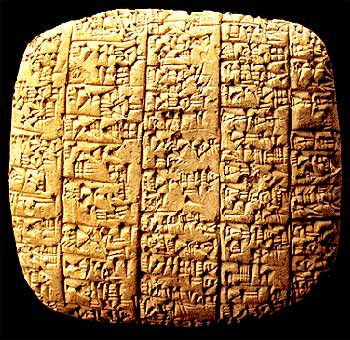
early writing Although ancient 9,500-year old towns and fortified cities have been discovered, Mesopotamia is often considered to be the oldest civilization in the world because of its size, organization and its contributions to world culture. It was founded in present-day Iraq, Turkey, Syria and Iran between the Tigris and Euphrates rivers during the fourth millennia B.C. It was originally thought that the heart of Mesopotamia was in southern Iraq. But this view is now been challenged as a number of large cities, dated to the same period, have been discovered further to the north.
For a long time, it seemed that hands down Mesopotamia was home to the oldest civilization in the world as the earliest phase of the Sumerian culture dates to around 4000 B.C. Tom Metcalfe, Live Science: But evidence uncovered in the past few decades indicates that the Sumerians have a few contenders, including ancient Egypt, for the title of "oldest civilization." The definition of what makes a civilization is vague, but generally a culture has to achieve several hallmarks, notably urbanism — that is, cities — irrigation and writing; and the Sumerians had all three. The Sumerians may have also invented religion. Some scholars argue that other civilizations may be as old or even older than that of the Sumerians. "I would say that Egypt and Sumer were basically contemporary in their emergence," said Philip Jones, the associate curator and keeper of collections at the Babylonian section of Philadelphia's Penn Museum. In recent years archaeologists in Egypt have now discovered writings just as early as the earliest writings from Sumer, which suggests the oldest phase of the ancient Egyptian civilization emerged at roughly the same time as the earliest phase of the Sumerian civilization: about 4000 B.C. [Source: Tom Metcalfe, Live Science, September 12, 2022]
Still another possibility is the Indus Valley civilization, which arose in parts of what is now Afghanistan, Pakistan and northwestern India, and dates from at least 3300 B.C., according to the earliest artifacts found there. But "we might find very early stuff in the Indus Valley," Jones said. "It wouldn't surprise me if we dug up something that was just as early." Jones suspects that early trade along the edges of the Indian Ocean helped these earliest civilizations — the Egyptian beside the Red Sea, the Sumerian at the north end of the Persian Gulf, and the Indus Valley civilization further east — develop from the pre-civilized people who lived there before them, by bringing them resources and ideas from further afield. "My gut feeling is that there was probably some trade networking going on the Indian Ocean," he said.
Today, many of the oldest Mesopotamia sites are little more than dirt mounds because mud brick, the primary building material, doesn’t last long. In many cases archaeologists can’t even figure what the buildings were because when mud brick deteriorates it becomes dirt that is difficult to distinguish from the dirt that surrounds it. The few buildings that have survived were made of baked brick and have been heavily renovated.
Mesopotamia, the World’s Longest-Lasting Civilization?
Mesopotamian civilization existed for well over 3,000 years, from the formation of the first cities at the end of the fourth millennium B.C. to the early years of the Roman empire. It, China and Ancient Egypt are all frequently cited as long-lasting civilizations but which lasted the longest? Tom Metcalfe wrote in Live Science: It turns out, that's not a straightforward question, for a few reasons. First, modern historians and archaeologists don't agree on a single definition of a civilization, including when one begins and when one ends, and many experts are doubtful whether civilizations can be measured in this way. Second, all great civilizations had periods when they were ruled by "foreigners" — the Hyksos in Egypt, for example — which complicates whether they should be considered continuous civilizations. Third, the culture near the beginning of a civilization might have been different from the culture near its end. As a result, many modern historians and archaeologists do not consider the idea of "civilization" useful; instead, they talk of "cultures" and "traditions." [Source: Tom Metcalfe, Live Science, May 28, 2023]
By most measures — the use of writing, the establishment of cities (what "civilization" originally meant) or continuous traditions — it seems the Chinese civilization may be the longest-lasting. How it should be measured, however, is disputed. "It depends on how you define civilization and how you define Chinese, because I think there are reasonable multiple ways you can define both of those concepts," Rowan Flad, an archaeologist at Harvard University and expert in the emergence of complex societies in China, told Live Science.
As an example, he highlighted Chinese writing; forms of the same symbols are used today and on the 3,200-year-old Oracle Bones, the earliest examples of writing in China. "When you think about the [Chinese] written language, there's absolutely no controversy that there's continuity from 3,250 years ago or so to the present," he said. But the same criterion can't be used elsewhere, Flad said. For example, the earliest writing in the Americas is attributed to the Olmecs in about 900 B.C. Writing was also known to the Maya after about 250 B.C. But the Incas, who ruled parts of South America for about 400 years until the Spanish conquest in the 16th century, seem to have had no writing (although they used knotted cords called quipu or khipu to encode information.)
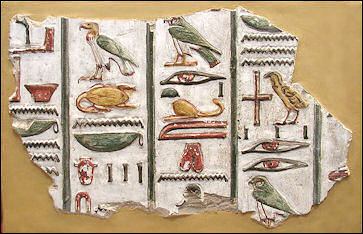
Egyptian Hieroglyphs Based on the archaeology of early states in what's now Chinese territory, including Neolithic ruins of the Liangzhu culture in the Yangtze River Delta, it's sometimes claimed that Chinese civilization is over 5,000 years old. But some historians see China's present as too different from its past for it to qualify as one continuous civilization. "I don't think that what is happening today in China is closely related to things that happened, say, before 1949 [China's revolution under Mao Zedong] or 1911 [the Xinhai revolution that ended China's last imperial dynasty]," Julia Schneider, a conceptual historian at University College Cork in Ireland, told Live Science.
Schneider, an expert in China's history, noted that pro-Chinese politicians and historians sometimes claim China's civilization is the world's longest-lasting, as "a point of legitimacy." But "what was Chinese? — that is the problem." The region encompassed a vast area and many different ethnicities at different times, and what happened in the Chinese heartlands could be "culturally very far away" than what happened elsewhere, she said.
Next to China, ancient Egypt and then Mesopotamia are usually considered the longest-lasting civilizations. By one estimate, measuring from the time of the first pharaohs and the use of hieroglyphic writing until its native religion was replaced by Christianity, the ancient Egyptian civilization endured for about 3,500 years. But Egypt was sometimes ruled by foreign dynasties, and both hieroglyphics and the Egyptian religion had different forms at certain times.
In Mesopotamia, Sumerian writing began in about 3200 B.C., and worship of Mesopotamian gods probably lasted until the third century A.D., Philip Jones, associate curator and keeper of collections at the Babylonian section of Philadelphia's Penn Museum, told Live Science. By that count, Mesopotamia might be seen as lasting as long as the Egyptian civilization.
Mesopotamia vs. Egypt
The civilizations of Egypt and Mesopotamia existed pretty much at the same time. Sumer in Mesopotamia is often credited with being the oldest civilization in the world because it came up with a writing system first. Although the two empires were only about 600 miles apart they developed as empires pretty much on their own. This is partly explained by the fact that there was a big desert between them. [Source: H.W. Janson,, "History of Art” Prentice Hall, Englewood Cliffs, N.J.]
For much of its early history Mesopotamia was occupied by rival kingdoms. Few of them were able to exert much influence beyond the borders of their realm. Sumer were not a unified kingdom.. Rather it was like ancient Greece, a composite of often feuding city-states. Babylon was a kingdom that did not control a very large area and did not rule terribly long. With the exception of the brief and unstable Akkadian empire around 2300 B.C. there was no kingdom that ruled over what would qualify as an empire until the Assyrians arrived on the scene in the 9th century B.C.
Another difference between the two cultures is that, at a given time, Egypt flourished under the leadership of one ruler and was relatively peaceful while Mesopotamia was often divided into several kingdoms and city-states and was racked by wars. This too is partly explained by geography. Mesopotamian kingdoms were spread out between two rivers and its many tributaries, and could be easily attacked from any direction, while ancient Egypt was located primarily within one river valley and was removed from the outside world by deserts. Attacks usually only came from the northeast — and to a lesser extent in the south — which meant defenses could be concentrated there. The fact that Mesopotamia was composed of many different kingdoms and city-states that rose, dominated, declined and battled each other also explains why it was never produced a single unified tradition of culture like Egypt. [Janson, Op. Cit] See First Writing
Mesopotamia and the Bible
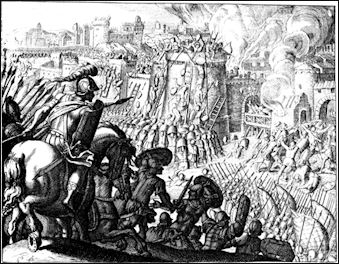
Middle Ages view of the
Babylonian siege of Jerusalem The first 11 chapters of Genesis are largely set in Mesopotamia. Eden is a Sumerian word meaning “steppe,” and was a district in Sumer. The Tower of Babel was in Babylon. The Hanging Gardens may have inspired the story of the Garden of Eden. According to Genesis Abraham and Cain and Abel and numerous other Biblical figures were born in Mesopotamia and the first cities founded after the flood were Babel (Babylon), Erech (Uruk), and Accad (Akkad) there.
Cuneiform tablets found in Ebla mention the cities of Sodom and Gomorrah and contain the name of David. They also mention Ab-ra-mu (Abraham), E-sa-um (Esau) and Sa-u-lum (Saul) as well as a knight named Ebrium who ruled around 2300 B.C. and bears an uncanny resemblance to Eber from the Book of Genesis who was the great-great grandson of Noah and the great-great-great-great grandfather of Abraham. Some scholars suggest that Biblical reference are overstated because the divine name yahweh (Jehovah) is not mentioned once in the tablets.
The Babylonians also had myths also that bore of striking resemblance to the creation of Eve from Adam’s rib and the story of Noah's Ark. See Literature.
Abraham was born under the name Abram in the Sumer city of Ur in Mesopotamia (in present day Iraq). According to Genesis, Abraham was the great, great, great, great, great, great, great, great grandson of Noah and was married to Sarah.Genesis 11:17-28, reads “Terah Begot Abram, Nahor, and Haran, and Haran begot Lot. And Haran died in the lifetime of Terah his Father in the land of his birth, Ur of Chaldees.”
Towns and Cities of Mesopotamia and References to Them in the Bible
Babylonia is often used to describe the region around the Euphrates River, which occupies a large chunk of Mesopotamia, and includes city-states frpm the Sumerian and Assyrian periods as well as the Babylonian period. According to the Catholic Encyclopedia:“The towns of ancient Babylonia were the following: southernmost: 1) “Eridu, Semitic corruption of the old name of Eri-dugga, "good city", at present the mounds of Abu-Sharain; 2) Ur, Abraham's birthplace, about twenty-five miles northeast of Eridu, at present Mughair. Both of the above towns lay west of the Euphrates. 3) East of the Euphrates, the southernmost town was Larsa, the Biblical Ellasar (Gen., xiv; in Vulg. and D.V. unfortunately rendered Pontus), at present Senkere; 4) Erech, the Biblical Arach (Gen., x, 10), fifteen miles northwest of Larsa, is at present Warka; |=|
“5) eight miles northeast from the modern Shatra was Shirpurla, or Lagash, now Tello. Shirpurla was one of Babylon's most ancient cities, though not mentioned in the Bible; probably "Raventown" (shirpur-raven), from the sacred emblem of its goddess and sanctuary, Nin-Girsu, or Nin-Sungir, which for a score of centuries was an important political centre, and probably gave its name to Southern Babylonia — Sungir, Shumer, or, in Gen., x, 10, Sennaar. Gishban (read also Gish-ukh), a small city a little north of Shirpurla, at present the mounds of Iskha, is of importance only in the very earliest history of Babylonia. |=|
“6) The site of the important city of Isin (read also Nisin) has not yet been determined, but it was probably situated a little north of Erech. 7) Calneh, or Nippur (in D.V., Gen., x, 10, Calanne), at present Nuffar, was a great religious centre, with its Bel Temple, unrivaled in antiquity and sanctity, a sort of Mecca for the Semitic Babylonians. Recent American excavations have made its name as famous as French excavations made that of Tello or Shirpurla. |=|
“7) In North Babylonia we have again, southernmost, the city of Kish, probably the Biblical Cush (Gen., x, 8); its ruins are under the present mound El-Ohemir, eight miles east of Hilla. 8) A little distance to the northwest lay Kutha, the present Telli Ibrahim, the city whence the Babylonian colonists of Samaria were taken (IV Kings, xvii, 30), and which played a great role in Northern Babylonia before the Amorite dynasty. 9) The site of Agade, i.e. Akkad (Gen., x, 10), the name of whose kings was dreaded in Cyprus and in Sinai in 3800 B.C., is unfortunately unknown, but it must have been not far from Sippara; it has even been suggested that this was one of the quarters of that city, which was scarcely thirty miles north of Babylon and which, as early as 1881, was identified, through British excavations, with the present Abu-Habba. |=|
“10) Lastly, Babylon, with its twin-city Borsippa, though probably founded as early as 3800 B.C., played an insignificant role in the country's history until, under Hammurabi, about 2300 B.C., it entered on that career of empire which it maintained for almost 2000 years, so that its name now stands for a country and a civilization which was of hoary antiquity before Babylon rose to power and even before a brick of Babylon was laid.” |=|
List of Rulers of Mesopotamia
Early Dynastic period:
Gilgamesh of Uruk (legendary): 2700 B.C.
Mesanepada of Ur: 2450 B.C.
Eannatum of Lagash: 2400 B.C.
Enannatum of Lagash: 2430 B.C.
Uruinimgina of Lagash: 2350 B.C.
Lugalzagesi of Uruk: 2350 B.C.
Dynasty of Akkad (Agade)
Sargon: 2340–2285 B.C.
Rimush: 2284–2275 B.C.
Manishtushu: 2275–2260 B.C.
Naram-Sin: 2260–2223 B.C.
Shar-kali-sharri: 2223–2198 B.C.
Dynasty of Lagash
Gudea(1): 2150–2125 B.C.
Third Dynasty of Ur
Ur-Nammu: 2112–2095 B.C.
Shulgi: 2095–2047 B.C.
Amar-Sin: 2046–2038 B.C.
Shu-Sin: 2037–2029 B.C.
Ibbi-Sin: 2028–2004 B.C.
Dynasty of Isin
Ishbi-Erra: 2017–1985 B.C.
Shu-ilishu: 1984–1975 B.C.
Iddin-Dagan: 1974–1954 B.C.
Lipit-Ishtar: 1934–1924 B.C.
Dynasty of Larsa
Rim-Sin: 1822–1763 B.C.
Old Babylonian dynasty
Sin-muballit: 1812–1793 B.C.
Hammurabi: 1792–1750 B.C.
Kassite dynasty
Kadashman-Enlil I: 1374–1360 B.C.
Burnaburiash II: 1359–1333 B.C.
Kurigalzu II: 1332–1308 B.C.
Babylonian dynasty
Nabu-mukin-zeri: 731–729 B.C.
Marduk-apla-iddina II: 721–710 B.C.
Shamash-shum-ukin: 667–648 B.C.
Neo-Babylonian dynasty
Nabopolassar: 625–605 B.C.
Nebuchadnezzar II: 604–562 B.C.
Amel-Marduk: 561–560 B.C.
Neriglissar: 559–556 B.C.
Labashi-Marduk: 556 B.C.
Nabonidus: 555–539 B.C.
Old Assyrian dynasty
Shamshi-Adad: 1813–1781 B.C.
Dynasty of Mari
Zimri-Lim: 1775 B.C.
Middle Assyrian dynasty
Ashur-uballit I: 1365–1330 B.C.
Enlil-nirari: 1329–1320 B.C.
Adad-nirari I: 1307–1275 B.C.
Tukulti-Ninurta I: 1244–1208 B.C.
Ashur-dan I: 1179–1134 B.C.
Tiglath-pileser I: 1114–1076 B.C.
Ashur-bel-kala: 1073–1056 B.C.
Neo-Assyrian dynasty:
Ashurnasirpal II: 883–859 B.C.
Shalmaneser III: 858–824 B.C.
Shamshi-Adad V: 823–811 B.C.
Adad-nirari III: 810–783 B.C.
Shalmaneser IV: 782–773 B.C.
Ashur-dan III: 772–755 B.C.
Ashur-nirari V: 754–745 B.C.
Tiglath-pileser III: 745–727 B.C.
Shalmaneser V: 726–722 B.C.
Sargon II: 721–705 B.C.
Sennacherib: 704–681 B.C.
Esarhaddon: 680–669 B.C.
Ashurbanipal: 668–627 B.C.
Ashur-etel-ilani: 626–623 B.C.
Sin-shar-ishkun: 622–612 B.C.
Ashur-uballit II: 611–609 B.C.
Mesopotamia United
Achaemenid Persian dynasty
Cyrus II the Great: 559–530 B.C.
Cambyses II: 530–522 B.C.
Darius I: 521–486 B.C.
Xerxes: 486–465 B.C.
Artaxerxes I: 465–424 B.C.
Darius II: 423–405 B.C.
Artaxerxes II: 405–359 B.C.
Artaxerxes III: 358–338 B.C.
Artaxerxes IV: 338–336 B.C.
Darius III: 336–330 B.C.
[Source: Department of Ancient Near Eastern Art. "List of Rulers of Mesopotamia", Heilbrunn Timeline of Art History, New York: The Metropolitan Museum of Art, http://www.metmuseum.org/toah/hd/meru/hd_meru.htm (October 2004)
Image Sources: Wikimedia Commons
Text Sources: Internet Ancient History Sourcebook: Mesopotamia sourcebooks.fordham.edu , National Geographic, Smithsonian magazine, especially Merle Severy, National Geographic, May 1991 and Marion Steinmann, Smithsonian, December 1988, New York Times, Washington Post, Los Angeles Times, Discover magazine, Times of London, Natural History magazine, Archaeology magazine, The New Yorker, BBC, Encyclopædia Britannica, Metropolitan Museum of Art, Time, Newsweek, Wikipedia, Reuters, Associated Press, The Guardian, AFP, Lonely Planet Guides, “World Religions” edited by Geoffrey Parrinder (Facts on File Publications, New York); “History of Warfare” by John Keegan (Vintage Books); “History of Art” by H.W. Janson Prentice Hall, Englewood Cliffs, N.J.), Compton’s Encyclopedia and various books and other publications.
Last updated June 2024



